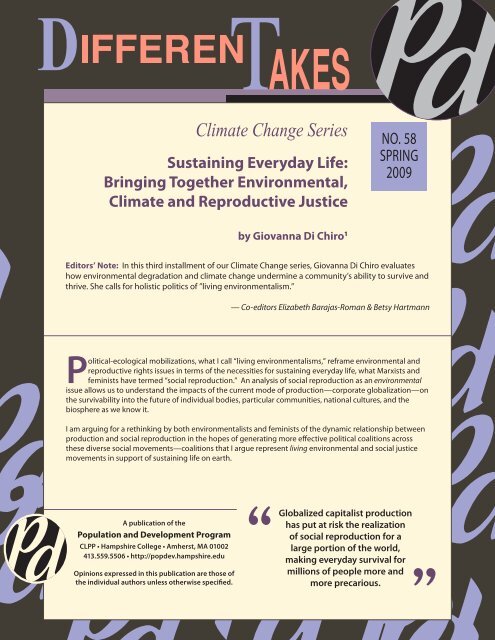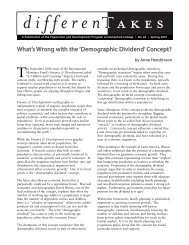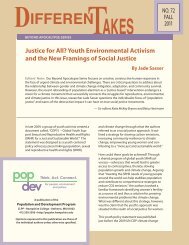Bringing Together Environmental, Climate and Reproductive Justice
Bringing Together Environmental, Climate and Reproductive Justice
Bringing Together Environmental, Climate and Reproductive Justice
You also want an ePaper? Increase the reach of your titles
YUMPU automatically turns print PDFs into web optimized ePapers that Google loves.
<strong>Climate</strong> Change SeriesSustaining Everyday Life:<strong>Bringing</strong> <strong>Together</strong> <strong>Environmental</strong>,<strong>Climate</strong> <strong>and</strong> <strong>Reproductive</strong> <strong>Justice</strong>NO. 58SPRING2009by Giovanna Di Chiro 1Editors’ Note: In this third installment of our <strong>Climate</strong> Change series, Giovanna Di Chiro evaluateshow environmental degradation <strong>and</strong> climate change undermine a community’s ability to survive <strong>and</strong>thrive. She calls for holistic politics of ”living environmentalism.”— Co-editors Elizabeth Barajas-Roman & Betsy HartmannPolitical-ecological mobilizations, what I call “living environmentalisms,” reframe environmental <strong>and</strong>reproductive rights issues in terms of the necessities for sustaining everyday life, what Marxists <strong>and</strong>feminists have termed “social reproduction.” An analysis of social reproduction as an environmentalissue allows us to underst<strong>and</strong> the impacts of the current mode of production—corporate globalization—onthe survivability into the future of individual bodies, particular communities, national cultures, <strong>and</strong> thebiosphere as we know it.I am arguing for a rethinking by both environmentalists <strong>and</strong> feminists of the dynamic relationship betweenproduction <strong>and</strong> social reproduction in the hopes of generating more effective political coalitions acrossthese diverse social movements—coalitions that I argue represent living environmental <strong>and</strong> social justicemovements in support of sustaining life on earth.A publication of thePopulation <strong>and</strong> Development ProgramCLPP Hampshire College Amherst, MA 01002413.559.5506 http://popdev.hampshire.eduOpinions expressed in this publication are those ofthe individual authors unless otherwise specified.Globalized capitalist productionhas put at risk the realizationof social reproduction for alarge portion of the world,making everyday survival formillions of people more <strong>and</strong>more precarious.
The Significance of Social ReproductionSocial reproduction, as feminist theorists define it, isabout the conditions necessary for reproducing everydaylife <strong>and</strong> includes the ability to procure healthy food,clean water, decent shelter, clothing <strong>and</strong> health care.These daily tasks are part of the political-economic,socio-cultural, material-environmental processesrequired to maintain life <strong>and</strong> to sustain human cultures<strong>and</strong> communities. Social reproduction encompasses theconditions for “biological reproduction, the reproductionof labor power, <strong>and</strong> the social practices connected tocaring, socialization, <strong>and</strong> the fulfillment of human needs,”as well as the social relations of power within which theseconditions are embedded. 2Globalized capitalist production has put at risk therealization of social reproduction for a large portionof the world, making everyday survival for millions ofpeople around the world more <strong>and</strong> more precarious.Feminist critics have been at the forefront in pointing outhow neoliberalism’s mantra of privatization, flexibility,<strong>and</strong> mobile capital has eroded the capitalist state’scommitment <strong>and</strong> responsibility for social reproductionsignified by 1) the withdrawal of governmententitlements <strong>and</strong> protections, 2) public disinvestmentsin education, social welfare, housing, healthcare <strong>and</strong>environmental regulation, <strong>and</strong> 3) the backing away ofcorporate commitment <strong>and</strong> investments in particularplaces, workforces, <strong>and</strong> communities. 3 Global economicrestructuring policies such as SAPs (structural adjustmentpolicies), welfare reform, environmental deregulation,<strong>and</strong> the privatization of public amenities such as water,sewage treatment, energy, <strong>and</strong> healthcare hit hardestin the arena of social reproduction, but they are rarelyanalyzed as such.Linking Ecology <strong>and</strong> Social ReproductionEcofeminist scholars <strong>and</strong> activists have drawn criticalconnections between issues of concern to both feminist<strong>and</strong> environmental movements. Overlapping issuesinclude environmental injustices based on race, gender,class, <strong>and</strong> sexuality, peace <strong>and</strong> anti-militarism, violenceagainst women <strong>and</strong> the “rape” of nature, <strong>and</strong> toxiccontamination <strong>and</strong> women’s reproductive health. 4The two movements, however, have not succeededin sustaining fruitful political alliances <strong>and</strong> coalitions.Even worse, the most enduring connection to issuesof “reproduction” identified by the mainstreamenvironmental movement has been what feministsconsider a negative one, that is, environmentalism’s focuson “overpopulation” <strong>and</strong> on reducing global populationgrowth by curtailing the “unsustainably high fertilityrates” of women from poor countries <strong>and</strong> poor women ofcolor in the United States. 5The use of alarmist population arguments that identifypoor women’s fertility as the major ecological threat tothe planet (conveniently shifting the blame from theconsumption <strong>and</strong> production patterns of the North) hasled to the implementation of aggressive <strong>and</strong> coercivepopulation control mechanisms that restrict women’sreproductive rights <strong>and</strong> endanger their health, <strong>and</strong> alsoto the support of regressive anti-immigrant policiesthat naturalize Third World women as “over-breeders”burdening the country’s resources <strong>and</strong> threateningnational security. 6In a similar vein, the mainstream/Northern women’smovement has been slow to recognize intersections withbroader environmental arguments or with the concernsraised by women of color <strong>and</strong> poor women aboutwhat it means to have access to reproductive “rights”<strong>and</strong> “choice.” For women whose communities strugglewith escalating poverty, inaccessible or dangerouscontraceptives, <strong>and</strong> poor health, the decision to havean abortion is largely not experienced as an act ofreproductive freedom or choice. Emphasizing this point,long time women’s rights activist, Loretta Ross, arguesthat for poor women of color, “our ability to controlwhat happens to our bodies is constantly challengedby poverty, racism, environmental degradation, sexism,homophobia, <strong>and</strong> injustice in the United States.” 7The intersectional politics of reproductive justice haslinked the rights to bodily self-determination <strong>and</strong>the right to safe contraception choices <strong>and</strong> abortion(the right to not have children) with the right to havechildren <strong>and</strong> to be able to raise them in nurturing,healthy, <strong>and</strong> safe environments. <strong>Reproductive</strong> justice,therefore, asserts that a wide scope of social, economic,<strong>and</strong> environmental issues must be seen as significantreproductive issues <strong>and</strong> include, for example, goodjobs <strong>and</strong> economic security, freedom from domesticviolence <strong>and</strong> forced sterilization, affordable healthcare,educational opportunities, decent housing, <strong>and</strong> accessto clean <strong>and</strong> healthy neighborhoods. This challenge bythe reproductive justice movement to the dominantdiscourse of reproductive-rights-as-abortion-rightspoints to the significance of the struggle to achieve socialreproduction for poor women <strong>and</strong> women of color.Sustaining Everyday Life: <strong>Environmental</strong><strong>Justice</strong> as Social ReproductionIn analyzing the meanings underlying the currentfascination with the idea of “sustainability,” I am evermore persuaded by the argument that all environmentalissues are reproductive issues; efforts to protect thehealth <strong>and</strong> integrity of natural systems—water, air, soil,biodiversity—are struggles to sustain the ecosystemsDIFFERENTAKES http://popdev.hampshire.edu 2
that make all life possible. In other words, environmentalstruggles are about fighting for <strong>and</strong> ensuring socialreproduction. It is activists in the environmentaljustice movement (EJM) that have most convincinglyforegrounded these everyday life (<strong>and</strong> death) stakesat the root of their environmental politics <strong>and</strong> havedeveloped an “environmentalism of everyday life.” 8Rather than underst<strong>and</strong>ing nature as an exotic elsewherethat is separate from our daily lives, activists in theEJM locate “nature” <strong>and</strong> the “environment” in theplaces we “live, work, play, <strong>and</strong> learn.” <strong>Environmental</strong>justice scholars <strong>and</strong> activists examine how thedeterioration of a community’s economic, social, <strong>and</strong>environmental conditions limits its sustainability (i.e.,social reproduction). Limiting conditions may includeliving next to a polluting facility that dumps toxicchemicals into your air <strong>and</strong> water, suffering high ratesof unemployment <strong>and</strong> poverty, living in subst<strong>and</strong>ardhousing, or having your tribe’s ancestral l<strong>and</strong> confiscatedto bury high-level nuclear waste. By joining togetherall of these diverse issues, activists in the EJM, who arepredominantly low-income women <strong>and</strong> women of color,redefine the popular concept of “sustainability” as thecapacity for a community to maintain economic <strong>and</strong>bodily security, to breathe clean air <strong>and</strong> water, <strong>and</strong> tonurture the next generation.<strong>Climate</strong> <strong>Justice</strong> <strong>and</strong> Everyday<strong>Environmental</strong>ismThe growing climate justice movement provides anexample of a political coalition linking environmental<strong>and</strong> reproductive issues by making visible thedisproportionate impact of global warming on poor <strong>and</strong>marginalized communities throughout the world. Formany activists, the problem of global climate changehas for too long been represented by the mainstreamenvironmental movement as an overly abstract <strong>and</strong>highly technical issue unrelated to the everyday lives<strong>and</strong> struggles of local communities: global warming wasmore about starving polar bears <strong>and</strong> melting ice capsthan about people’s daily survival.By relocalizing the negative effects of global warming,environmental justice activists from around theworld reframe this story of a planet in peril broughton by reckless industrial practices <strong>and</strong> unsustainableconsumption as a grassroots concern putting at riskpeople’s health, homes, families, <strong>and</strong> livelihoods.Activists such as Beverly Wright, from the Deep SouthCenter for <strong>Environmental</strong> <strong>Justice</strong> in New Orleans, <strong>and</strong>Sara James, an Alaskan Gwich’in tribal leader from theIndigenous <strong>Environmental</strong> Network, explain how globalwarming will exacerbate the preexisting, long-termconsequences of disinvestments in social reproductionWe want to build a green economythat has the power to deliver work,wealth <strong>and</strong> health for low-incomepeople while honoring the earth.—Van Jonesalready suffered by poor <strong>and</strong> low-income people fromaround the world. These include increased healthproblems due to rising temperatures for people alreadysuffering cancer, asthma, <strong>and</strong> respiratory disorders fromliving next to oil refineries <strong>and</strong> petrochemical plants; arise in economic <strong>and</strong> food insecurity from the increasingenergy costs <strong>and</strong> food prices connected to unpredictableagricultural output; <strong>and</strong> increased risks to life <strong>and</strong>livelihood associated with severe weather, storms, <strong>and</strong>flooding exacerbated by government negligence <strong>and</strong>deferred maintenance in infrastructure, housing, <strong>and</strong>public transportation systems. 9Activists in the growing international climatejustice movement have brought their analyses <strong>and</strong>recommendations to the international stage at the nongovernmentalforums that run parallel to the UnitedNations Framework Convention on <strong>Climate</strong> Changemeetings, the most recent held in Poznán, Pol<strong>and</strong> inDecember 2008. This global network of locally-basedactivists has called on the UN member states to embracesustainable global economic policies that would takeseriously both the planetary dangers to the earth’secosystems <strong>and</strong> the capacity for the vast majority ofpeople around the world to achieve social reproduction.<strong>Climate</strong> justice activists in the U.S., for example, havelaunched the “Green for All” (greenforall.org) initiativededicated to creating environmental justice solutionsto global warming by configuring a new clean-energyeconomy. The initiative rejects the prevailing marketbasedpolicies for reducing carbon emissions agreedupon in the Kyoto Protocol 10 <strong>and</strong> instead calls for thecreation of innovative solutions that can ensure a healthyenvironment for all <strong>and</strong> can “lift people out of poverty.”Green for All co-founder Van Jones proposes that a greeneconomy rooted in a “just sustainability” generatessustainable solutions that fix multiple problems at thesame time. <strong>Climate</strong> justice activists like Jones, Wright,<strong>and</strong> James argue that the seemingly unrelated problemsof global warming, rising unemployment <strong>and</strong> povertyrates, <strong>and</strong> increasing incidences of reproductive cancers<strong>and</strong> childhood asthma <strong>and</strong> diabetes can be solved by 1)developing non-polluting renewable energy generationsystems <strong>and</strong> green industries, 2) creating healthy,sustainable jobs that provide a living wage, <strong>and</strong> 3)DIFFERENTAKES http://popdev.hampshire.edu 3
promoting policies for locally-based, organic food systems that support farm-to-school programs <strong>and</strong> provide nutritiousfood for school children. Eloquently expressing the power of an intersectional analysis that recognizes the linkagesbetween escalating environmental problems such as global warming <strong>and</strong> dwindling access to social reproduction, Jonescalls for a “social-uplift environmentalism”:“We want to build a green economy that has the power to deliver work, wealth, <strong>and</strong> health for low-income people, whilehonoring the earth. We want to create green pathways out of poverty <strong>and</strong> into great careers for America’s children. Wewant this ‘green wave’ to lift all boats. This country can save the polar bears <strong>and</strong> poor kids too.” 11Innovative environmental coalitions committed to climate justice, such as the Green for All movement, which articulatepeople’s concerns about their families’ <strong>and</strong> communities’ access to social reproduction are generating dynamic, livingenvironmentalisms that may st<strong>and</strong> a chance at compelling people to take stronger action to fight even the big problems,like global warming.About the AuthorGiovanna Di Chiro is a Research Associate in the <strong>Environmental</strong> Studies Department at Mount Holyoke College. Shehas published widely on the intersections of gender, race, scientific expertise, <strong>and</strong> environmental justice. She is coeditorof the volume Appropriating Technology: Vernacular Science <strong>and</strong> Social Power (University of Minnesota Press) <strong>and</strong>is completing a book titled Embodied Ecologies: Science, Politics, <strong>and</strong> <strong>Environmental</strong> <strong>Justice</strong>. Di Chiro is co-founder of thePioneer Valley Community <strong>Environmental</strong> <strong>Justice</strong> Coalition <strong>and</strong> collaborates with environmental justice organizationsto conduct community-based research on environmental health disparities in the low-income communities of WesternMassachusetts.Notes1 An earlier <strong>and</strong> longer version of this paper was published in <strong>Environmental</strong> Politics, Vol. 17, No.1 (2008), 276-298.2 Isabel Bakker, <strong>and</strong> S. Gill, eds., Power, Production <strong>and</strong> Social Reproduction (London: Macmillan-Palgrave, 2003), 4.3 ibid4 Noel Sturgeon, Ecofeminist Natures: Race, Gender, Feminist Theory, <strong>and</strong> Political Action (New York: Routledge, 1997).5 Betsy Hartmann, <strong>Reproductive</strong> Rights <strong>and</strong> Wrongs: The Global Politics of Population Control (Boston: South End Press, 1995).6 Betsy Hartmann <strong>and</strong> Ann Hendrixson, “Pernicious Peasants <strong>and</strong> Angry Young Men: The Strategic Demography of Threats,” in BetsyHartmann et al., eds., Making Threats: Biofears <strong>and</strong> <strong>Environmental</strong> Anxieties (Lanham, Md: Rowman & Littlefield, 2005).7 Jael Silliman et al., eds, Undivided Rights: Women of Color Organize for <strong>Reproductive</strong> <strong>Justice</strong> (Cambridge, Mass: South End Press, 2004), 4.8 Devon Peña, Mexican Americans <strong>and</strong> the Environment: Tierra y Vida. (Tucson: University of Arizona Press, 2005), 1539 Manuel Pastor, et al., In the Wake of the Storm: Environment, Disaster, <strong>and</strong> Race After Katrina (New York: Russell Sage Foundation,2006).10 Larry Lohmann, “Carbon Trading,” Development Dialogue, No. 48 (September 2006). Available at:http://www.thecornerhouse.org.uk/summary.shtml?x=54422511 Van Jones, The Green Collar Economy (New York: HarperCollins, 2008), 16.DIFFERENTAKES http://popdev.hampshire.edu 4




